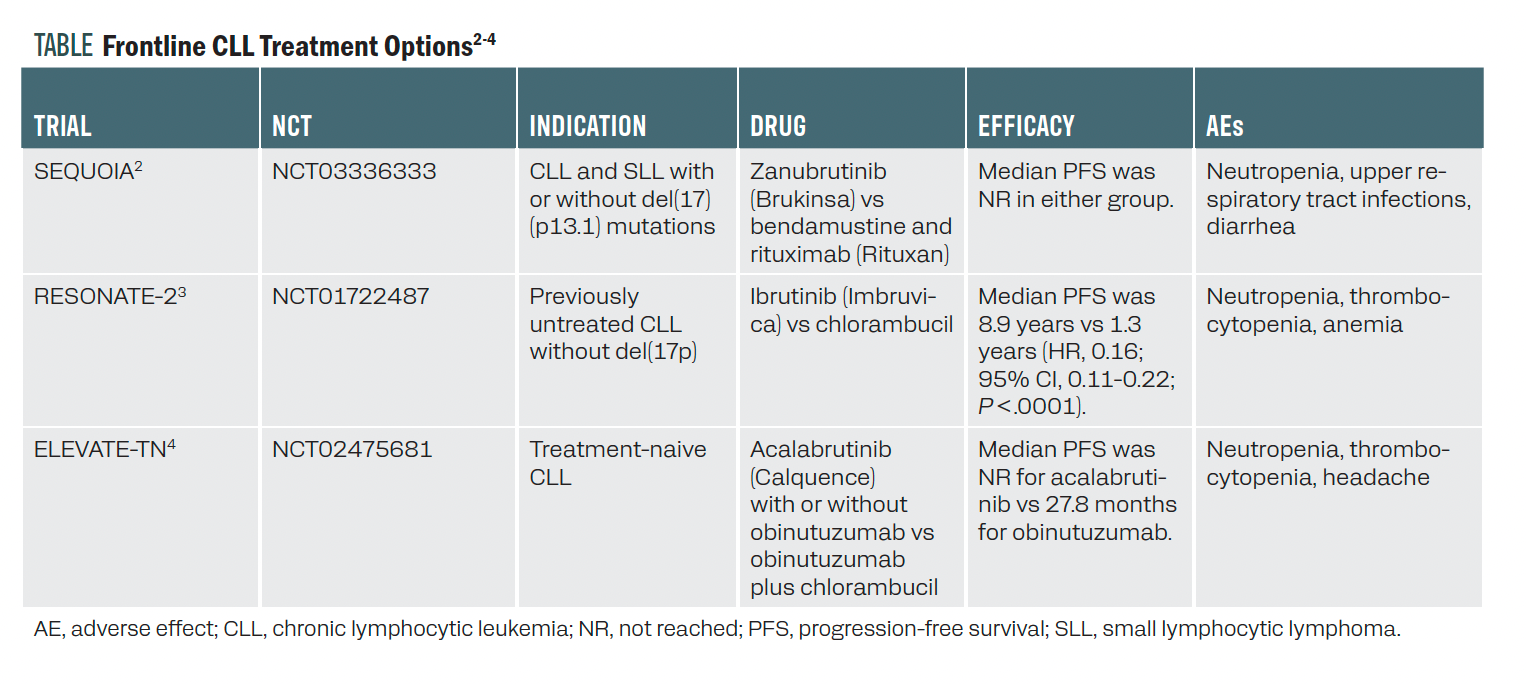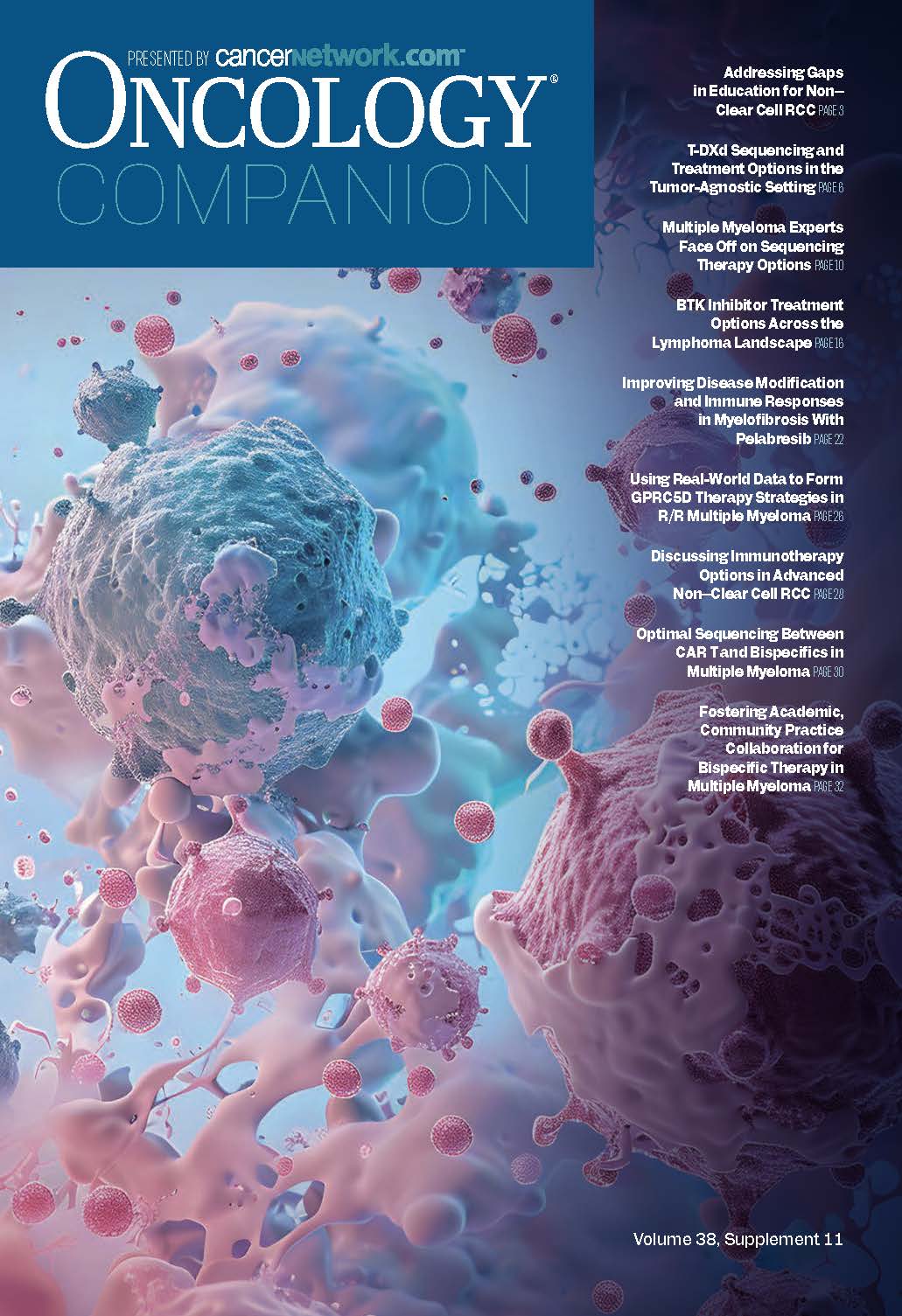BTK Inhibitor Treatment Options Across the Lymphoma Landscape
Clinicians focused on CLL, follicular lymphoma, and MCL gathered during a Frontline Forum to discuss the use of BTKi in each respective disease state.
Meet the experts

Clinicians focused on chronic lymphocytic leukemia (CLL), follicular lymphoma, and mantle cell lymphoma (MCL) gathered during a Frontline Forum to discuss the use of Bruton tyrosine kinase (BTK) inhibitors in each respective disease state. The panel was led by Christopher R. Flowers, MD, MS, from The University of Texas MD Anderson Cancer Center in Houston.
Other panelists from MD Anderson included Neha Akkad, MD; Ajlan Al Zaki, MD, PhD; Jan A. Burger, MD, PhD; Dai Chihara, MD, PhD; Fateeha Furqan, MD; Hannah Goulart, MD; Michael R. Green, PhD; Preetesh Jain, MBBS, MD, DM, PhD; Chijioke Nze, MD, PhD; Michael Wang, MD; and William G. Wierda, MD, PhD. David Scott, MBChB, PhD, is from BC
Cancer in Vancouver, British Columbia, Canada.
The panel focused on frontline management of CLL, sequencing therapies, the use of BTK inhibitors in follicular lymphoma, and emerging therapies in MCL. The discussion also highlighted how to best manage treatment-related adverse effects (AEs).
Guidelines and Sequencing for CLL
According to the National Comprehensive Cancer Network (NCCN), the 10-year overall survival (OS) rate for CLL is approximately 80% for those with low-risk disease, 52% for those with intermediate-risk disease, and 26% for high-risk disease.1 Wierda, who sits on the panel for NCCN, said they have recently changed the CLL guidelines from being prescriptive to giving clinicians more options on what treatment regimens or paths to choose. Currently, his goal is for patients to attain disease remission to allow them time off therapy; however, older patients may need to consider continuous maintenance because of the venetoclax (Venclexta) ramp-up of certain options.
Burger mentioned the 2 avenues that can be taken regarding NCCN Category 1 recommendations. The first includes BTK inhibitor monotherapy, which is long-term and reduces disease burden slowly. The second includes venetoclax and obinutuzumab (Gazyva), which reduces disease burden quickly and puts disease into deeper remission. He believes the BTK inhibitor options are more widely used in the United States; however, it looks like this may be changing.
“There’s growing interest to explore these time-limited treatments as an alternative. That’s very attractive for the younger patients and for the older patients. It’s convenient to use BTK inhibitor monotherapy, but that’s the landscape,” Burger said. Flowers then wanted to go through some topline data for each of the trials with the current therapy option (Table2-4).
TABLE. Frontline CLL Treatment Options2-4

Based on results from the phase 3 RESONATE-2 (NCT01722487) trial, where a PFS was finally made known, Burger wondered whether continuous BTK therapy would be part of the future. He also noted OS data were observed in this trial and 2 other trials that looked at 1500 patients and their age-matched population without leukemia. Results from the study found the OS curves overlapped, which shows the advantage of ibrutinib use.
Chihara wanted more clarity on these results, as the OS rates were only slightly higher than the PFS rates. At the 10-year follow-up, patients were still dying. Burger commented that although it wasn’t disclosed in the paper, death-related events were perhaps a mix of CLL progressions and those who came off treatment and began another regimen.
From an MCL perspective, Wang noted that if ibrutinib is given for long periods, most patients will present with atrial fibrillation. He noted that ibrutinib is not used often in MCL anymore because of the AEs observed.
Although Scott has had the most experience with ibrutinib, there seem to be fewer AEs observed with the newer agents of acalabrutinib (Calquence) and zanubrutinib (Brukinsa). For Burger, he dose reduces ibrutinib by significant amounts from the 420-mg recommended dosage. This has allowed those patients who have been on ibrutinib long term to mitigate AEs and avoid switching over to second-generation BTK inhibitors.
“I have been getting calls from the specialty pharmacy or insurance companies saying, ‘You can’t prescribe acalabrutinib for this patient. You have a choice. You can give them ibrutinib or zanubrutinib,’ which may be related to coverage and contracting and cost, but I have seen more recently where the insurance or the specialty pharmacy will allow an option of a second generation and it’s restricted. It wouldn’t be one or the other,” Wierda said.
Goulart, who practices in a county hospital setting, thinks in terms of what can be obtained in a timely manner. She has been able to successfully transition patients from ibrutinib because of atrial fibrillation and hypertension to acalabrutinib or zanubrutinib. She noted that conversations need to occur with the patients about the current treatment offerings, which can be easier to administer and may not take much monitoring or frequent visits.
Akkad agreed with Goulart, noting that most patients who are receiving this treatment are older. They think in terms of adherence, so acalabrutinib or zanubrutinib may be easier options, as they are in the form of a continuous pill vs ibrutinib infusions.
A presentation from the 2024 American Society of Clinical Oncology Annual Meeting in Chicago, Illinois, assessed real-world data of switching and sequencing of next-line therapy for patients who have received BTK inhibitors as first-line or second-line CLL/SLL treatment.5 Top-line results found that regardless of the therapy-switching day of 60 days or less or 61 to 89 days, it was statistically significantly lower for patients receiving zanubrutinib vs acalabrutinib and ibrutinib as first-and second-line therapy (P <.0001).
Flowers noted that 10% of patients who had zanubrutinib switched in the first 60 days, with corresponding rates of 17% with acalabrutinib and 13% with ibrutinib. Flowers asked Burger whether switching agents in either line of treatment is something he commonly sees in practice.
“[For] some patients, when you start them, let’s say, on ibrutinib, they develop severe myalgias or joint aches, and then maybe dose reduction doesn’t help and you switch. I would say 10% to 20% sounds realistic, and oftentimes these switches fix the problem for good,” Burger said.
Treatment Management Updates in CLL
Flowers turned to the phase 3 ELEVATE-RR trial (NCT02477696), which assessed ibrutinib vs acalabrutinib in patients with relapsed/refractory CLL.6 The independent review committee (IRC) PFS was 38.4 months in both arms, and the median OS was not reached. The IRC-assessed overall response rate (ORR) was 81% in the acalabrutinib arm and 77% in the ibrutinib arm.
The phase 3 ALPINE trial (NCT03734016) looked at zanubrutinib vs ibrutinib in patients with relapsed/refractory CLL.7 The PFS rates in the overall population were 64.9% in the zanubrutinib arm vs 54.8% in the ibrutinib arm. For those with del(17p) TP53 mutations, the PFS rates were 58.6% vs 41.3%.
The experts highlighted that treatment with CD20 antibodies and BTK inhibitors leads to blunted vaccine responses. Clinicians now caution patients to get their vaccines completed before starting treatment. During the COVID-19 pandemic, patients died because of the poor vaccine responses.
Wierda agreed but noted that there are nirmatrelvir tablets (Paxlovid) and remdesivir (Veklury), so not as many patients are dying from COVID-19 as before. Green highlighted that there hasn’t been a great effort in profiling BTK inhibitors and the immune system. He hopes there will be more peripheral immune profiling with the new BTK inhibitors.
In terms of sequencing, Goulart makes sure treatment is feasible for her patients, which is why she mostly recommends BTK inhibitors. Akkad noted in the community that it’s hard to break people away from “comfort” regimens. She hasn’t had a lot of success using obinutuzumab plus venetoclax because of the ease of use for single-agent BTK inhibitors.
“At [the US Department of Veterans Affairs], there’s usually not a problem getting the drugs, because most of the drugs, if there [are] data, are covered. It’s getting the patients to the clinic. If a patient [experiences progression], there’s a long period in between [them being seen again]. Their priorities change in between, and they develop more comorbidities. Taking all these things into account, what I’ve done is usually use a BTK inhibitor at that time. I’ve not used ibrutinib, but between acalabrutinib and zanubrutinib, it’s patient preference most of the time,” Furqan said.
Regarding the atrial fibrillation most commonly observed with ibrutinib use, Scott typically sends patients to the cardio-oncology team for anticoagulation. With the entrance of acalabrutinib and zanubrutinib, there is the opportunity to switch or use a venetoclax-based regimen.
BTK Inhibitor Treatment Options for Follicular Lymphoma
When looking at all options on how to approach first-line treatment in follicular lymphoma, Chihara assesses tumor burden, which has different treatment options to use. For those with high tumor burden, he prefers to use bendamustine plus rituximab and will dose reduce bendamustine if the patient has frailty.
Akkad agreed with this assessment, as it is a shorter regimen for patients to receive. From mentor guidance, she prefers to save rituximab plus cyclophosphamide, doxorubicin hydrochloride, vincristine sulfate, and prednisone (R-CHOP) for later lines of therapy.
Green believes that if bendamustine is given and followed too closely with an immunomodulatory therapy, chimeric antigen receptor T-cell therapy, or bispecific, the responses tend to be worse. He wondered why the combination of lenalidomide (Revlimid) and rituximab was not more commonly used, as it is more stable from site to site of disease and from diagnosis to relapse.
“There’s a whole range of biomarkers out there, which probably aren’t worth much, but a number of gene expression profiles are now coming out. When they apply these to differently treated patients, they flip. Patients [with] high risk on R-CHOP had low risk on bendamustine and vice versa. We can probably start to use these to select treatments down the line. There’s a lot more work, and it needs to be locked down,” Nze said.
Scott noted that according to the treatment history of most patients with follicular lymphoma, they have been through many lines of therapy. Particularly in his older patients, he’s looking for ways to dose reduce and mitigate toxicity.
Chihara finds it challenging to decide what to use as a second-line therapy if the first-line therapy will be lenalidomide and rituximab. He believes once bispecifics receive FDA approval for second-line therapy, it will help open up treatment options across the board.
A second-line option can also be a monotherapy, Nze said, but it depends on the tumor volume. He has been reevaluating the use of tazemetostat (Tazverik) for use in the second line.
Flowers asked Wang whether there are any tools to help decide treatment for the third-line setting and beyond for follicular lymphoma. Wang responded that there is a lot that is being evaluated prospectively, such as spatial transcriptomics. This tool allows retention of the 2D structure of the cell and includes the interfollicular and extrafollicular space as well as defining cellular niches.
Wang noted that for this to be more attainable to help define second-and third-line therapies, more biopsies need to be performed prior to clinical trial enrollment. When this happens, it needs to be done in a uniform way so it can be compared study to study.
BTK Inhibitors for Follicular Lymphoma
The phase 2 ROSEWOOD trial (NCT03332017) assessed the use of zanubrutinib plus obinutuzumab vs obinutuzumab alone for patients with relapsed/refractory follicular lymphoma who had received 2 or more lines of therapy.8 The trial met its primary end point of ORR of 69% (95% CI, 61%-76%) in the combination arm vs 46% (95% CI, 34%-58%) in the monotherapy arm (P = .0012).
The approval of zanubrutinib for follicular lymphoma was based on results from the phase 2 ROSEWOOD trial.9 Nze highlighted that with this approval, there is now a solid treatment option for the third-line setting and beyond. Flowers, who worked on designing this trial, said that crossover was allowed: “If you look at the response rate in the crossover group, the group that got obinutuzumab first and then got zanubrutinib/obinutuzumab afterward had a lower response rate than the group that got zanubrutinib as the initial [treatment].”
Navigating Emerging MCL Therapies
In British Columbia, Scott treats patients older than 65 years with bendamustine plus rituximab followed by 2 years of maintenance. He believes this regimen is great for patients who have low risk but may not be a great option for patients with high risk based on results from the phase 3 SHINE trial (NCT01776840).10
Jain chimed in about the MCL NCCN guidelines, which stated results from the phase 3 TRIANGLE trial (NCT02858258), involving maintenance after a BTK inhibitor post transplant, showed an improvement in outcomes.11 Real-world data found maintenance post transplant or post remission after first-line chemotherapy improved outcomes. However, when using a BTK inhibitor for maintenance, results showed the same outcomes as transplant.
“The conclusion is that we can no longer afford chemotherapy in the front line. [Minimal residual disease] is leading the field, and we want everybody to use chemotherapy-free therapies. That takes time to convince people. Even for the patients who [have] high risk, we have consolidations. We have other means to not use chemotherapy. Chemotherapy is detrimental to our patients. We have powerful agents. We use many protocols. Most of the data show that chemotherapy-free therapies are superior,” Wang said.
For Jain, when a patient experiences relapse, he first looks at the type and whether it is high-risk, disseminated, or localized. If a patient has a localized relapse and has received an covalent BTK inhibitor followed by radiation and another covalent BTK inhibitor, acalabrutinib and zanubrutinib are available. Akkad noted that if there is not an NCCN guideline for a specific treatment regimen, it will not get approved by her practice.
Furqan wanted to know whether it was ever acceptable to hold treatment to give patients a COVID-19 vaccine and give them time to respond to it, as infections are a major toxicity associated with BTK inhibitors. Both Jain and Wang said it would be OK to consider or would be acceptable if the patient was experiencing remission.
Moving forward, a key area to investigate in MCL would be TP53 mutations and the tumor microenvironment. Wang believes BTK inhibitors should be given the frontline treatment option and have multicenter randomized trials.
References
- NCCN. Clinical Practice Guidelines in Oncology. Chronic lymphocytic leukemia/small lymphocytic lymphoma, version 1.2025. Accessed October 8, 2024. https://shorturl.at/EVH2v
- Tam CS, Brown JR, Kahl BS, et al. Zanubrutinib versus bendamustine and rituximab in untreated chronic lymphocytic leukaemia and small lymphocytic lymphoma (SEQUOIA): a randomised, controlled, phase 3 trial. Lancet Oncol. 2022;23(8):1031-1043. doi:10.1016/S1470-2045(22)00293-5
- Findings from landmark RESONATE-2 study confirm sustained survival benefit of IMBRUVICA (ibrutinib) for first-line chronic lymphocytic leukaemia treatment with up to 10 years follow-up. News release. Johnson & Johnson. June 14, 2024. Accessed October 8, 2024. https://shorturl.at/tDjcJ
- Sharman JP, Egyed M, Jurczak W, et al. Acalabrutinib ± obinutuzumab vs obinutuzumab + chlorambucil in treatment-naive chronic lymphocytic leukemia: six-year follow-up of Elevate-TN. Blood. 2023;142(suppl 1):636. doi.10.1182/blood-2023-174750
- Pinilla-Ibarz J, Xue M, Wu E, et al. Real-world treatment switching and sequencing to next line of therapy of zanubrutinib, acalabrutinib, and ibrutinib in CLL/SLL. J Clin Oncol. 2024;42(suppl 16):e19022. doi.10.1200/JCO.2024.42.16_suppl.e19022
- Seymour JF, Byrd JC, Ghia P, et al. Detailed safety profile of acalabrutinib vs ibrutinib in previously treated chronic lymphocytic leukemia in the ELEVATE-RR trial. Blood. 2023;142(8):687-699. doi:10.1182/blood.2022018818
- Brown JR, Eichhorst B, Hillmen P, et al. Zanubrutinib or ibrutinib in relapsed or refractory chronic lymphocytic leukemia. N Engl J Med. 2023;388(4):319-332. doi:10.1056/NEJMoa2211582
- Zinzani PL, Mayer J, Flowers CR, et al. ROSEWOOD: a phase II randomized study of zanubrutinib plus obinutuzumab versus obinutuzumab monotherapy in patients with relapsed or refractory follicular lymphoma. J Clin Oncol. 2023;41(33):5107-5117. doi:10.1200/JCO.23.0077
- FDA grants accelerated approval to zanubrutinib for relapsed or refractory follicular lymphoma. FDA. March 7, 2024. Accessed October 8, 2024. https://shorturl.at/LgCJ8
- Wang ML, Jurczak W, Jerkeman M, et al; SHINE Investigators. Ibrutinib plus bendamustine and rituximab in untreated mantle-cell lymphoma. N Engl J Med. 2022;386(26):2482-2494. doi:10.1056/NEJMoa2201817
- NCCN. Clinical Practice Guidelines in Oncology. B-cell lymphomas, version 3.2024. Accessed October 8, 2024. https://shorturl.at/2R4R0

Newsletter
Stay up to date on recent advances in the multidisciplinary approach to cancer.
Highlighting Insights From the Marginal Zone Lymphoma Workshop
Clinicians outline the significance of the MZL Workshop, where a gathering of international experts in the field discussed updates in the disease state.